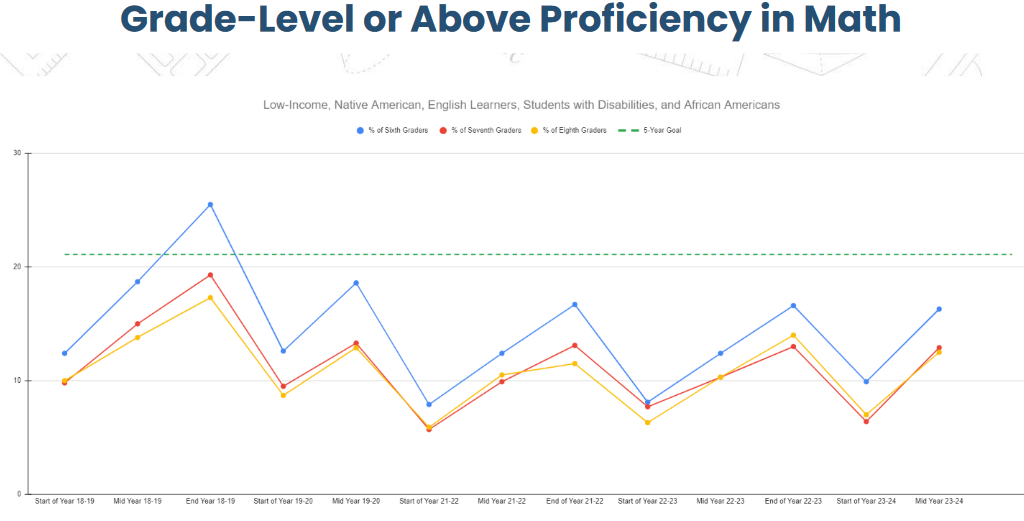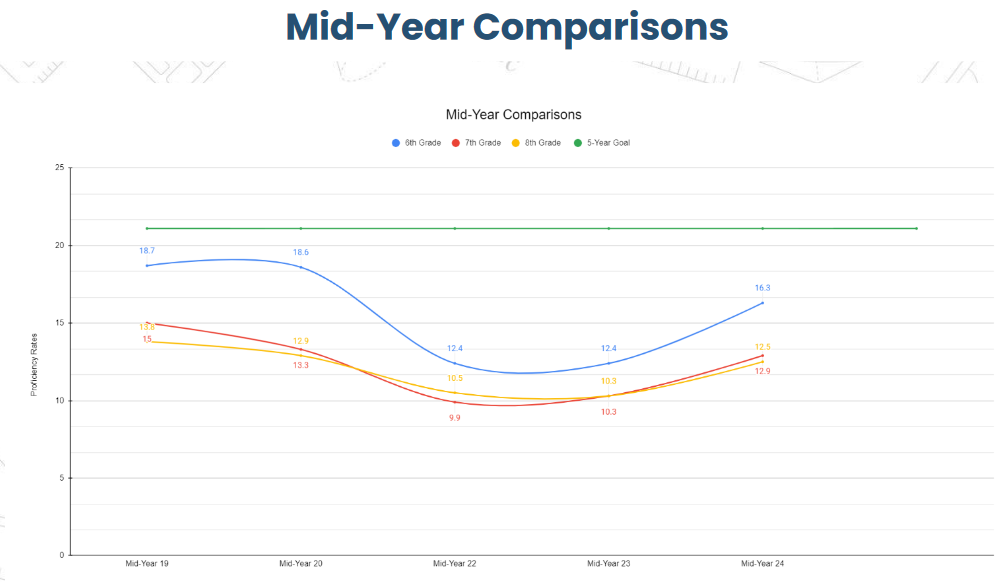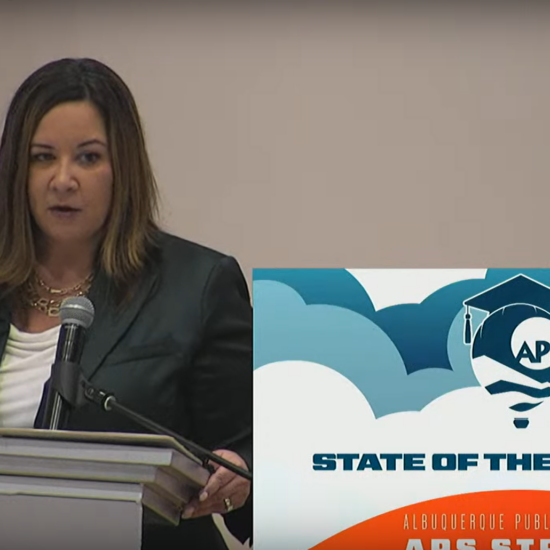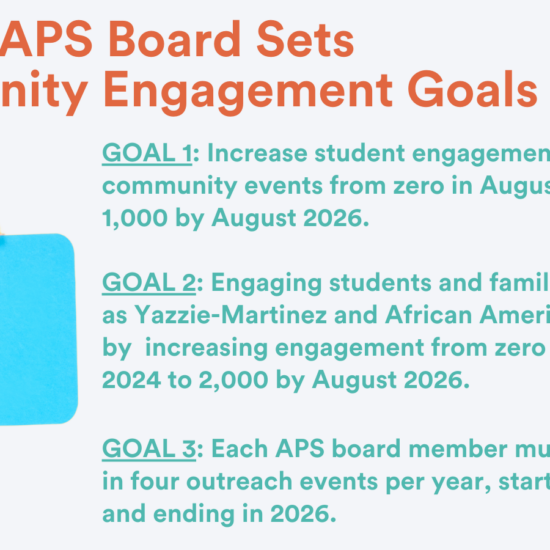
The Albuquerque Public Schools Board of Education in their regular progress monitoring of district goals, heard that the district is seeing an increase in math proficiency. However, there is a growing achievement gap between certain minority students and their non-minority peers.
The March 20 review was part of the district’s plan to monitor progress towards the four goals adopted by the APS Board of Education in 2023, aligned with the district’s Emerging Stronger Strategic Plan. Each of the four goals have interim goals that serve as indicators of progress. This meeting was focused on discussing progress towards the second of the district’s four goals, which prioritizes increasing student proficiency in math.
GOAL 2: MATH PROFICIENCY
The percentage of eighth-grade students identified in the Yazzie-Martinez decision and African American students who demonstrate grade level proficiency or above on the state mathematics summative assessment will increase from 11.1 percent in May 2023 to 21.1 percent in May 2028.
- Interim Goal 2.1: The percentage of sixth-grade students identified in the Yazzie-Martinez decision plus African American students who demonstrate grade level proficiency or above as predicted by i-Ready will increase from 16.6 percent in May 2023 to 22.6 percent in May 2026.
- Interim Goal 2.2: The percentage of seventh-grade students identified in the Yazzie-Martinez decision plus African American students who demonstrate grade level proficiency or above as predicted by iReady will increase from 13 percent in May 2023 to 19 percent in May 2026.
- Interim Goal 2.3: The percentage of eighth-grade students identified in the Yazzie-Martinez decision plus African American students who demonstrate grade level proficiency or above as predicted by iReady will increase from 14 percent in May 2023 to 20 percent in May 2026.
APS is focusing on improving the results of their most vulnerable students by measuring the progress of groups recognized in the Yazzie Martinez lawsuit. Those groups include Native Americans, English learners, socioeconomically disadvantaged children, and students with disabilities; while not recognized in the Yazzie-Martinez lawsuit, APS is also reviewing the results of Black students.
APS has set a regular progress to monitor the district’s goals. In January, APS monitored their literacy results. In April, the board will be reviewing student readiness for leaving high school and entering college or the workforce. To see the APS monitoring calendar, click here.
At the last review meeting, APS Chief of Schools Channel Segura said that incoming-Superintendent Gabriella Blakey had directed her team to make the goal monitoring information easier to access and understand. Now, parents, students, and the APS community can access all information used by APS to monitor progress towards the goals including, progress monitoring reports, and questions from the Board of Education with answers from APS staff here.
Specifics on APS’ Goal 2 report from the March 20 meeting can be found here.
Monitoring Goal 2
Goal 2 is monitored using data from the iReady assessment, which measures student progress in mathematics for 6th, 7th, and 8th-grade students. This assessment is given three times annually: at the start of the school year, mid-year, and at the year’s end.
The progress monitoring report for Goal 2 was presented by Dr. Antonio Gonzales, Chief Academic Officer; Dr. Channell Segura, Chief of Schools; and Dr. Richard Bowman, Chief Information and Strategy Officer.
Interim Goal 2.1
Goal 2.1 states, “The percentage of 6th-grade students identified in the Yazzie-Martinez decision plus African American students who demonstrate grade level proficiency or above as predicted by iReady will increase from 16.6 percent in May 2023 to 22.6 percent in May 2026.”
Dr. Gonzales reported a significant improvement in mathematics proficiency among 6th-grade students, with an increase from 17.5 percent at the beginning of the year to 23.2 percent at mid-year.
“We are observing positive movement toward our set objectives,” Gonzales said, “which is encouraging.”
Specifically, the Yazzie-Martinez and African American student subgroups saw a 6.4 percentage point increase in proficiency, rising from 9.9 percent to 16.3 percent within the same period.
APS Concerns
Despite overall growth among 6th graders and gains among Yazzie-Martinez and African American student groups, the “all other students” group experienced a larger proficiency increase, widening the achievement gap.
From fall 2023 to mid-year, “all other students” jumped from 45.6 percent to 62.9 percent in math proficiency.
“This disparity underscores the necessity for targeted strategies to uplift our identified groups,” Gonzales said, explaining that while progress is made, it is uneven across student demographics.
Interim Goal 2.2
Goal 2.2 states, “The percentage of 7th-grade students identified in the Yazzie-Martinez decision plus African American students who demonstrate grade level proficiency or above as predicted by iReady will increase from 13 percent in May 2023 to 19 percent in May 2026.”
For 7th graders, APS witnessed a rise in overall math proficiency by 5.3 percentage points, moving from 13.2 percent to 18.5 percent from the beginning to the middle of the year.
In the targeted Yazzie-Martinez and African American groups, the increase was even more substantial at 6.5 percentage points, improving from 6.4 percent to 12.9 percent.
APS Concerns
The report highlighted that while there’s growth in 7th-grade math proficiency, the rate of improvement for the targeted student groups does not match the acceleration seen in other student groups.
Interim Goal 2.3
Goal 2.3 is written, “The percentage of 8th-grade students identified in the Yazzie-Martinez decision plus African American students who demonstrate grade level proficiency or above as predicted by iReady will increase from 14 percent in May 2023 to 20 percent in May 2026.”
Dr. Gonzales shared that APS saw a 4.5 percentage point increase in math proficiency among 8th-grade students overall, moving from 14.2 percent to 18.7 percent from the start to the mid-year assessment.
The proficiency rate for Yazzie-Martinez and African American students in 8th grade showed a 5.5 percentage point increase, from 7 percent to 12.5 percent.
APS Concerns
Despite these gains, similar to 6th and 7th grades, the growth rate for targeted groups lags behind that of their peers, emphasizing the continuous need for targeted support.
What is Going Well?
Segura highlighted overall progress in math proficiency across the middle grades, with significant achievements in both the general student population and the Yazzie-Martinez and African American subgroups.
Gonzales praised the district’s efforts in providing high-quality instructional materials and professional development for educators, facilitating the monitoring and support of classroom progress towards achieving math proficiency goals.
Furthermore, the participation rate in the i-Ready assessment was notably high, with 95 percent of students completing the assessment, ensuring a robust data set for guiding interventions and instructional strategies.
Next Steps
After hearing the presentation from district staff, the board unanimously decided to table the monitoring report, meaning the board did not accept the review. Board members explained the report did not have enough information about why the achievement gap was widening.
“Increasing instructional time and providing targeted support will be pivotal in bridging the gaps in mathematics proficiency, particularly among our students identified in the Yazzie-Martinez decision plus African American students. Our objective is to ensure that all students, regardless of their background, have the opportunity to achieve at high levels in mathematics. This includes intensifying our efforts in professional development for teachers, ensuring that our instructional strategies are both effective and equitable. By closely monitoring the implementation of these strategies and the progress of our students through the iReady assessment data, we aim to make informed adjustments that will lead to improved outcomes for all students,” explained Segura.
Segura said APS plans to focus on refining and expanding its multi-tiered system of support (MTSS) to better identify and address the needs of students who require additional assistance in mathematics. This approach will include targeted interventions for students below grade level, as well as enrichment opportunities for those who are performing at or above grade level, ensuring that all students are challenged and supported appropriately.
Gonzales added, “Our journey toward achieving Goal 2 is a collective effort that involves educators, students, families, and the community. We are committed to transparency in our progress monitoring reports and to continuous improvement in our practices. By working together, we are confident that we can achieve and even surpass our ambitious goals for student math proficiency.”
Board member Courtney Jackson acknowledged that through this discussion the board was able to learn what steps are being taken to close the achievement gap, but because this information was not directly outlined in the March report, she motioned to table the report.
Unanimously, the board approved to table this report.
“We don’t have to have another discussion if all of the material is provided. If the board feels the criteria is met, then we can approve without discussion [at the next meeting],” President Gonzales said.








